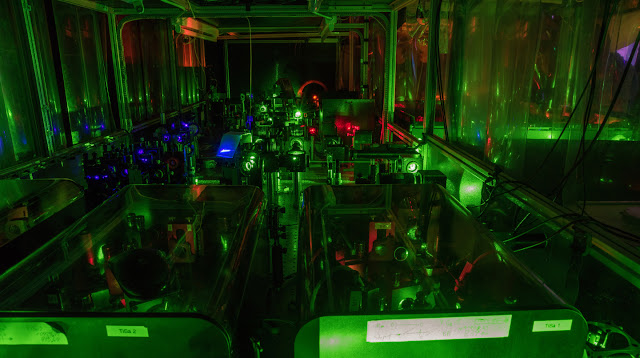CERN - European Organization for Nuclear Research logo.
1 Oct 2018
An unprecedented combination of experimental nuclear physics and theoretical and computational modelling techniques has been brought together to reveal the full extent of the odd-even shape staggering of exotic mercury isotopes, and explain how it happens. The result, from an international team at the ISOLDE nuclear physics facility at CERN, published today in Nature Physics, demonstrates and explains a phenomenon unique to mercury isotopes where the shape of the atomic nuclei dramatically moves between a football and rugby ball.
Isotopes are forms of an element that contain the same number of protons in their nuclei but different numbers of neutrons. The properties of different isotopes can be exploited in a variety of ways including archaeological and historical dating (Carbon 14) and medical diagnostics. Stable isotopes have an optimal ratio of protons to neutrons. However, as the number of neutrons decreases or increases, structural changes to the nucleus are required and the isotope typically becomes unstable. This means it will spontaneously transform itself towards a stable isotope of another element through radioactive decay. Isotopes with extreme neutron to proton ratios are typically very short-lived, making them difficult to produce and study in the laboratory. ISOLDE is the only place in the world that can study such a wide range of exotic isotopes.
Lasers at ISOLDE. RILIS experiment (Image: Noemi Caraban/CERN)
One of the earliest experiments in the ISOLDE facility observed dramatic nuclear shape staggering in the chain of mercury isotopes for the first time. That more than 40 year old result showed that although most of the isotopes with neutron numbers between 96 and 136 have spherical nuclei, those with 101, 103 and 105 neutrons have strongly elongated nuclei, the shape of rugby balls. That discovery has remained one of ISOLDE’s flagship results, but it was so dramatic that it was difficult to believe.
In this new result, the experimental team used laser ionisation spectroscopy, mass spectrometry and nuclear spectroscopy techniques to take a closer look at how, why and when these quantum phase transitions take place. Not only did the team reproduce the results of the historic experiment (observing isotopes up to Mercury 181), by producing and studying four additional exotic isotopes (177- 180), it also discovered the point at which the shape staggering ceases and mercury isotopes return to normal isotope behaviour. Several theories had tried to describe what was happening, but none was able to provide a full explanation.
“Due to the extreme difficulty in producing such exotic nuclei, as well as the computational challenge of modelling such a complex system, the reasons for this shape staggering phenomenon remained unclear,” explains Bruce Marsh. “It is only now, with new developments of ISOLDE’s Resonance Ionisation Laser Ion Source (RILIS), and by joining forces with other ISOLDE teams, that we have been able to examine the nuclear structure of these isotopes.”
These experimental observations were in themselves outstanding, but the collaboration wanted to conclude the story by explaining the shape staggering effect theoretically. Using one of the world’s most powerful supercomputers, theorists in Japan performed the most ambitious nuclear shell model calculations to date.
These calculations identified the microscopic components that drive the shape shifting; specifically, that four protons are excited beyond a level predicted by expectations of how other stable isotopes in the nuclear landscape behave. These four protons combine with eight neutrons and this drives the shift to the elongated nuclear shape. In fact, both nuclear shapes are possible for each mercury isotope, depending on whether it is in the ground or excited state, but most have a football shaped nucleus in their ground state. The surprise is that Nature chooses the elongated rugby ball shape as the ground state for three of the isotopes.
“Ingenuity and innovation are characteristics of the ISOLDE community and the generation and measurement of the suite of mercury isotopes is a particularly beautiful example,” said Eckhard Elsen, CERN’s Director for Research and Computing. “I am even more impressed that the theoretical explanation of the puzzling behaviour using supercomputer modelling was provided at the same time.
Note:
CERN, the European Organization for Nuclear Research, is one of the world’s largest and most respected centres for scientific research. Its business is fundamental physics, finding out what the Universe is made of and how it works. At CERN, the world’s largest and most complex scientific instruments are used to study the basic constituents of matter — the fundamental particles. By studying what happens when these particles collide, physicists learn about the laws of Nature.
The instruments used at CERN are particle accelerators and detectors. Accelerators boost beams of particles to high energies before they are made to collide with each other or with stationary targets. Detectors observe and record the results of these collisions.
Founded in 1954, the CERN Laboratory sits astride the Franco–Swiss border near Geneva. It was one of Europe’s first joint ventures and now has 22 Member States.
Related links:
ISOLDE: http://home.cern/about/experiments/isolde
Nature Physics: http://dx.doi.org/10.1038/s41567-018-0292-8
For more information about European Organization for Nuclear Research (CERN), Visit: https://home.cern/
Image (mentioned), Text, Credits: CERN/Corinne Pralavorio.
Greetings, Orbiter.ch


